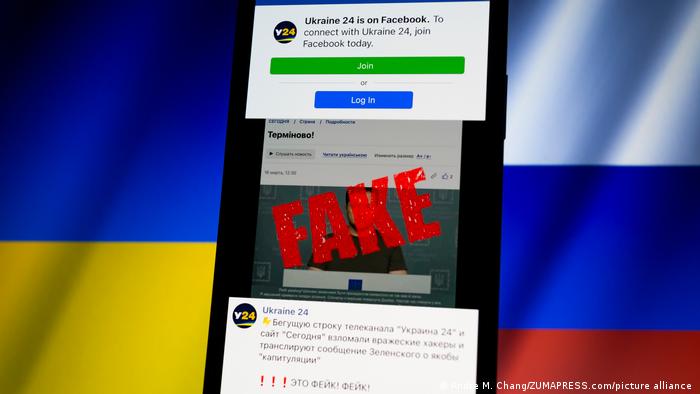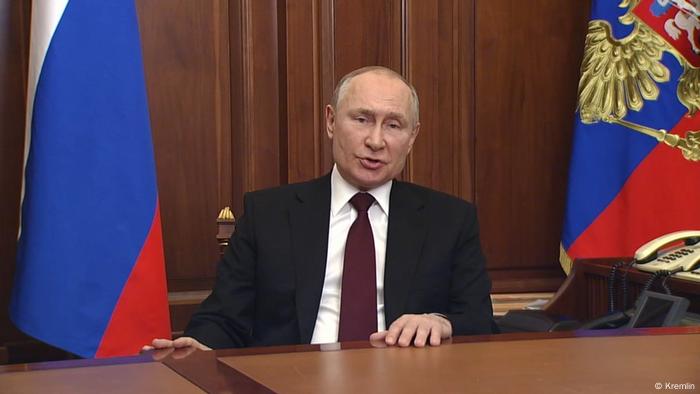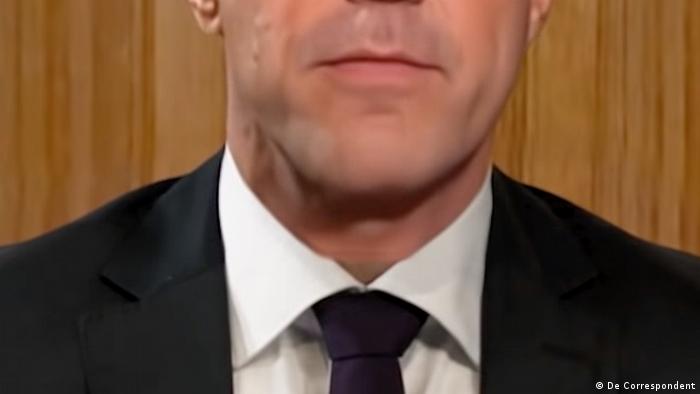Fact check: The deepfakes in the disinformation war between Russia and Ukraine
Videos of Russia's Vladimir Putin and Ukraine's Volodymyr Zelenskyy have been used to create deepfakes with a message that favors their adversary. They are not true, but they still quickly spread online.

Russia's war in Ukraine has impacted disinformation on social media by
people supporting either side of the conflict
Manipulated videos designed to look like someone said or did something they did not — known as deepfakes — have targeted politicians for years. With higher stakes amid Russia's war in Ukraine, however, such videos could have a swift and devastating impact on those directly involved in the conflict.
DW Fact Check takes a look at some of the recent deepfakes that circulated on social media amid the conflict.
Deepfake of Putin
This deepfake of Russian President Vladimir Putin appeared on Twitter in March. The manipulated video of Putin was shared on social media with many describing it as showing Putin urging Russian soldiers to lay down their weapons and go home. But DW's Russia service reveals that this is not what the fake audio says.

This screenshot of the video address the Kremlin released on February 21.
Notice the crisp detail around Putin's collar and head —
details that are blurred or irregular in the deepfake
In the deepfake, the manipulated audio says: "Negotiations with the Ukrainian side have just started. And they were successful for the Russian side. I will inform you shortly. So, we have reached peace with Ukraine. With Ukraine in its world-recognized borders with Donetsk and Luhansk oblasts (territories). We have agreed that we will set up a large foundation together with the USA and the EU for the restoration of infrastructure in these Ukrainian regions. We also signed a five-year roadmap on restoring Crimea's independence as a republic within Ukraine. In the negotiations, I was guided by one principle: to preserve peace and the lives of the Slavic peoples. Russian language in Ukraine will remain — and there will be no oppression, just like the oppression of the Russian population. It is clearly written in peace agreements."
In reality, Putin never said this. As is the case with previous deepfake videos of other people, these audio and mouth movements were manipulated through the use of artificial intelligence programs.
This deepfake appears to have been made by using an authentic video of Putin giving a national address from the Kremlin released on February 21 after Russia recognized the independence of two separatist regions in eastern Ukraine.
Deepfake targets Zelenskyy
A manipulated video depicting Ukrainian President Volodymyr Zelenskyy circulated on social media in March that appears to show the Ukrainian leader telling his soldiers to lay down their arms and surrender to Russia. Its message was also posted to the website of broadcaster Ukraine 24 — but the news outlet soon after posted a statement saying it was hacked and removed the article.
Zelenskyy, who has consistently rallied allies to aid Ukraine in the fight against Russia, never made the statement.
When the deepfake video was flagged as a fake it was quickly removed from social media platforms including Facebook, Twitter and YouTube (an exception appears to be made for posts that explicitly state it is a deepfake to raise awareness).
In the video, Zelenskyy's lips appear to be moving, but when looking closely, the head is in a static position throughout the 1-minute clip and his jawline is not defined. Ukrainian viewers also pointed out that Zelenskyy's accent was off and that his voice did not appear authentic.
Zelenskyy addressed the deepfake on his official social accounts with a video statement.
In his statement, Zelenskyy said: "If I can offer someone to lay down their arms, it's the Russian military. Go home. Because we're home. We are defending our land, our children & our families."
Mock attack to stir emotions
Another form of manipulated content has also gone viral on social media: mock videos. One viral video was produced with special effects to illustrate what an attack on Paris would look like. The aim was to warn nearby European countries that Russia had to be stopped now in Ukraine before they, too, were attacked.
The mock video starts with a woman posing next to the Eiffel Tower, and then multiple explosions strike iconic buildings nearby, including from several angles. Later shots include the sound of shocked people speaking in French and the sound of air raid sirens as fighter jets fly over. White text then appears: "Just think if this were to happen in another European capital."
The video ends with a written quote from Zelenskyy: "We will fight till the end. Giving us a chance to live. Close the sky over Ukraine, or give us air fighters. If we fall, you fall."
"Close the sky" is a phrase often used by Zelenskyy when urging the European Union and NATO allies to close airspace with a no-fly zone over Ukraine in a bid to deter Russia from launching further attacks by air.
The video was shared by multiple Ukrainian official social media accounts, like that of Oleksandr Merezhko,the chair of the Ukrainian Foreign Affairs Committee, with the words: "We also thought that it could never happen." It was also posted on the Twitter account of Ukraine's Defense Ministry on March 12 and, the night before, the video was posted by the Ukrainian parliament and the Ministry of Culture and Information Policy.
A week later, the video is still being shared on social media, especially after Zelenskyy’s speech at the US Congress as well as the German parliament. Always with the same message: "Close the skies."
Russian media were quick to point out that the video is a clear fake — but some went further, such as in the Telegram group called for "War on Fakes," claiming that Ukrainian authorities deliberately created the fake video using computer graphics to urge Europe to create a no-fly zone over Ukraine.
But this is contradicted by the man who says he created the video. He posted it on Facebook before the Ukraine parliament shared the video.
In interviews with the French newspaper Le Monde and broadcaster RTL, Ukrainian filmmaker Olias Barco said he was not ordered by the Ukrainian authorities to create the video. "It's something I wanted to do myself, with producer Jean-Charles Levy, to give the West a shock," he said to Le Monde. "For me, we are in the Third World War, and this conflict is going to become more widespread. This is an anticipation film not a propaganda film."
DW was not able to independently verify Barco's account.
Many Ukrainians on social media have referenced a Russian TV interview to support their stance that Moscow would not stop at Ukraine and would seek to gain control of other European countries. In this video, Duma member Oleg Matveychev was a guest on a segment on Russia 1 talking about the conflict in Ukraine, "The most important thing: There is no way we can stop halfway. Like leaving Lviv or something like that. Otherwise, we shouldn’t even have started it." The presenter of the show then goes even further by saying: "I say more. With such sanctions — who said that you have to stop at the borders of Ukraine at all."
How do I spot a deepfake?
The sophisticated manipulation of videos makes it increasingly harder to detect — but there are signs that clue you in on what is a deepfake.
DW Fact Check has published a guide here. 
HOW TO SPOT A DEEPFAKE
Deepfake clue — edges of the face swap
Interesting fold that Dutch leader Mark Rutte has there on his collar. Inconsistencies can be found at the edges of a face swap. These are mostly visible when those edges are close to clothing, hair or jewelry. Can you spot it?
1234567
Edited by: Stephanie Burnett
No comments:
Post a Comment